Elizabeth Harrin's Blog, page 28
February 16, 2023
Winning stakeholder support when time and energy are limited
 Jo Ann Sweeney
Jo Ann SweeneyWhy should project teams invest resources in communication activities is a question I’m often asked – both from people who are not convinced of the value, and also from those looking for the words to use with their leadership team.
For me the crux of this question comes back to the raison d’etre for projects. It doesn’t matter whether we are introducing new systems, processes or skills; all projects are about changing the way people do their jobs. If we don’t persuade end users to change, our project will fail.
One of the fallacies I hear repeatedly is that people can be forced to change. They can’t. There are a multitude of subtle and overt ways people can undermine change that we are powerless to prevent when we do not invest in relationships and communication.
Magically, when we do invest in communications we can win support from the majority of our stakeholders. I use a simple model, developed by Bill Quirke, when I want to explain how to my clients.
The Communication EscalatorThe Communication Escalator graphically depicts change communications as a rising staircase along which our stakeholders journey from initial awareness to commitment. Each step represents at least one communication activity.
At the bottom of the escalator the focus is on building cognitive knowledge, in the middle it is on developing positive emotions, and at the top it is on persuading people to take action that demonstrates their involvement.
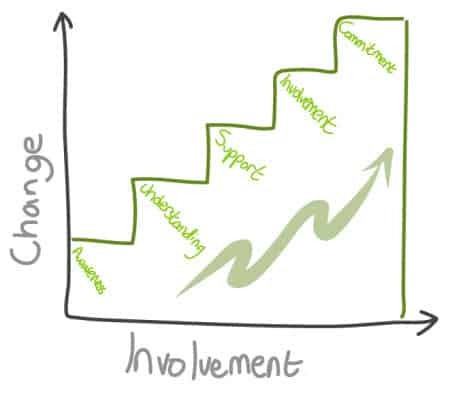 The Communications Escalator, adapted from Bill Quirke’s book, Communicating Corporate ChangeAwareness
The Communications Escalator, adapted from Bill Quirke’s book, Communicating Corporate ChangeAwarenessCommunication activities at this first step are usually one-way flows of information so stakeholders understand the essentials about our change project as it affects them in their roles.
UnderstandingAt this second step stakeholders receive additional information tailored more closely to their needs, including rationale, ad we request feedback to check their level of understanding.
SupportAt this third step we seek to change our stakeholders’ attitudes so they are positive and supportive. We want them to accept the need for the change we are introducing, trust the rationale behind it and, potentially, accept the change itself.
InvolvementAt this fourth step we invite stakeholders to be involved in our project in some way, perhaps by providing input to decision-making, or participation in pilots.
CommitmentHere at the final step our aim is to have stakeholders champion our project to others – to have them tell others about the benefits of our project to their tea and the organization. They may also be willing to defend us when other people criticize our project or achievements to date.
Not all our stakeholders will travel to the top of our escalator. How far they go depends on two criteria:
How much power they have to influence the outcome of the projectHow much they will be impacted by the project.Thus our communication resources are focused on those stakeholders who have the greater power and those who will be most impacted. This helps enormously in change teams that don’t have huge amounts of time and energy. What they do have can then be effectively focused on their key stakeholders.
This article first appeared at Rebel's Guide to Project Management
February 15, 2023
Why do stakeholders contribute?
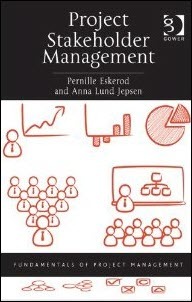
Why do stakeholders take part in projects? You might think that’s an obvious question.
After all, your project sponsor is probably the one who wanted this project to happen in the first place, and he or she has a vested interest in making it a success. But aside from the sponsor, all those other stakeholders don’t have to play nicely. They make an active choice to either help out, or hinder your project.
It’s a question asked in Project Stakeholder Management by Pernille Eskerod and Anna Lund Jepsen (part of Gower’s Fundamentals of Project Management series). It talks about why stakeholders make the choice to contribute to projects.
Eskerod and Jepsen say that before stakeholders make a commitment to a project they weigh up:
The expected consequences, both in terms of benefits and costsWhat others will think about their involvementObstacles for making a contribution.Stakeholders might not work through this list and make conscious decisions, of course. It can be a very illogical process that they may not even be aware of. But as a result of those thought processes, however chaotic and unconscious, they will decide whether or not to contribute and if they will contribute, how much they will contribute.
Assessing the consequencesProject stakeholders obviously cannot know exactly how the project will work out, because it hasn’t happened yet.
They also don’t have all the information to be able to make an informed decision about the expected consequences of their involvement in the project, as they probably have less information about the project than you do. Instead, they will consider their perception of the consequences, and use that as a decision-making tool.
The consequences of their involvement could be positive or negative. There are both benefits to being involved, and costs. The benefits are things like:
Being involved with a high-status, high profile projectIncreased exposure to senior leadersTangible outcomes for their department such as the project deliverables like new softwareBeing able to shape the direction of the project as an early adopter instead of just accepting the changes later when the pilot is complete – getting in on the groundGetting more skills for themselves or their team membersCareer progression for themselves or their team members.Costs are the other side of the equation, things that they will have to ‘pay’ in order to take part in the project like:
Offering up resources in the form of people or servicesMoney from their budget to fund the projectThe time commitmentThe administrative overhead of taking part in a projectThe potential for negative publicity or a negative impact on their career if the project goes badly.A stakeholder will mentally run through all of these and end up with a judgement about what is in it for them. There are probably a host of other things that you can think of that may affect a stakeholder’s willingness to contribute to a project.
If you can work out what is bothering any particular stakeholder, you can work with them to overcome these issues and get a more positive outcome from them.
Concerns about contributingSome people may be very keen to contribute but find that something is holding them back, consciously or unconsciously. One of these things could be what other people will think.
Peer pressure is prevalent in office environments, and what other people think about their involvement in the project is bound to form part of the decision making process for stakeholders.
You can help them make the ‘right’ decision by encouraging them to see their contribution in a positive light, as something that someone in their position would naturally or logically do – assuming, of course, that you do want them to contribute! Otherwise I suppose you could encourage them the other way.
Stakeholders also consider influences from their own environment, outside of the project, so you could lobby those around them so that they hear positive messages from their own communities. This could include talking to their boss or mentor, or providing other options for positive role models to show that their community would value their involvement with this project.
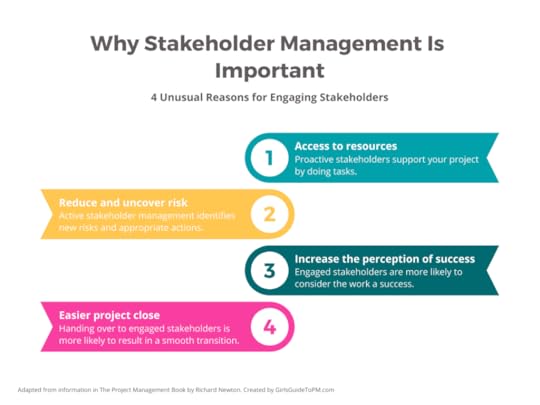 Can they contribute?
Can they contribute?Another reason why people may be reluctant to spend time working with you on the project is that perhaps they don’t feel capable of contributing in the way that you require. They may not have the skills they need, or they may feel as if they don’t.
You can help by encouraging them and boosting their confidence. You can also help in practical ways, such as providing training. One of the reasons people don’t want to get involved with projects is that they perceive a significant overhead in administration or in project jargon – the mysteries of project management.
If you are expecting them to use software you can point out how easy they are to use and even provide some training. Once people have a good grasp of what is required of them, they will be less reluctant to commit to the project.
Finally, they may need permission to contribute, so even if they are very keen, they may still be waiting for their line manager to give them the go ahead.
If you suspect that this is what is holding them back, have a quiet word with them and then approach their manager and ask him or her to release your stakeholder for some work on the project. Your stakeholder may have had a gut feeling that permission would be refused, but if you don’t ask, you’ll never find out!
Buy on Amazon.co.uk [image error]
This article first appeared at Rebel's Guide to Project Management
4 ways to proactively manage stakeholders
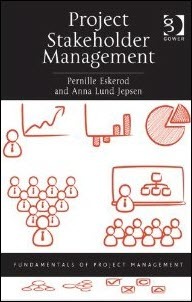 Pernille Eskerod and Anna Lund Jepsen’s book, Project Stakeholder Management
Pernille Eskerod and Anna Lund Jepsen’s book, Project Stakeholder ManagementStakeholder management seems to stay a hot topic regardless of what year we’re in. I think it’s been that way since A Guide to the Project Management Body of Knowledge (PMBOK® Guide) finally included a tenth knowledge area on managing stakeholders (although in my mind, stakeholders were important to the project management profession way before PMI wrote it into the book).
Working with people is never going to go out of fashion, and when it was first published, Pernille Eskerod and Anna Lund Jepsen’s book, Project Stakeholder Management, was timely. It remains relevant today.
In the book, they argue that proactive stakeholder management is far better than adopting a reactive ‘wait and see’ approach. I completely agree, so much so that I wrote the APM’s guide to stakeholder engagement (which is how we talk about this work today — ditching the ‘management’ moniker).
Eskerod and Jespen set out 4 ways to proactively manage stakeholders in their book. These are:
Sustain their positionChange their attitudeActivate their help potentialReduce their harm potentialLet’s look at each of these in turn and see how they could affect stakeholder plans for your project.
1. Sustain their positionStakeholders who already feel positively about the project need to stay feeling that way. Eskerod and Jepsen suggest you do this through keeping them informed, acknowledging their position on the project and ‘engaging’ them.
You can do this through project newsletters, providing information and inviting them along to relevant meetings. It shouldn’t be too difficult to keep someone who is already keen about the project feeling that way. The key thing is not to neglect them, as this can lead to their interest waning.
2. Change their attitudeStakeholders who feel negatively about the project present a different set of challenges for a project manager. You obviously want them to be involved, but not in a negative way.
If they have a key position, such as controlling resources, they can be a real roadblock to the success of the project, so you should invest some effort in trying to change their attitude and move them towards feeling positively about the project.
Eskerod and Jepsen suggest that you do this through talking to them about the consequences of their behaviour, although I would add that you’ll have to do this sensitively.
You can address their expectations, the benefits of the project, and the relevance that the project has to them personally and professionally. In other words, use all your wily ways to convince them that the project is A Very Good Thing.
Techniques to use to do this are talking (face-to-face is better), inviting them along to workshops so they’ll hear all the great stuff about the project, and giving them a formal role on the project so they feel involved, relevant and important. It all sounds like pandering to their egos to me, but if it works, it works.
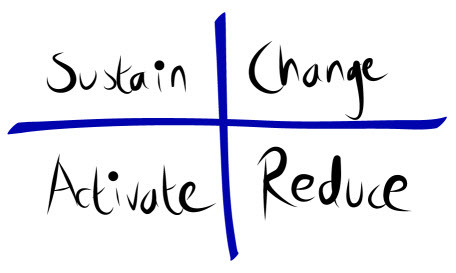 The 4 ways to proactively engage stakeholders3. Activate their help potential
The 4 ways to proactively engage stakeholders3. Activate their help potentialHelp potential is how much a stakeholder has it in their power to help you. Any type of stakeholder, whether they feel positively or negatively about the project, could help you in some way and it’s important to be able to tap into that when you need it.
Some ways that you can do this include telling them what you want (sounds obvious, but sometimes people are so busy with their own stuff that they don’t realize how to help) and using “power-based pressure”. I expect this latter only works with people you can throw you weight around with.
Alternatively, you could get someone higher up than them, such as their manager, to ask them to help out. Eskerod and Jepsen also suggest that you can make it look more appropriate for them to help – in other words, point out that someone in their position really should be helping this project and it is a completely logical and appropriate thing for them to do.
To get these stakeholders off their backsides and helping out as they should be, you can give them clear instructions, get them involved with people who are already modelling the kind of behaviour you want to see, and invite them to be involved in project planning.
4. Reduce their harm potentialHarm potential is the opposite of help potential. It’s the extent to which a stakeholder has the power to mess up your project. Even stakeholders who feel positively about the project could do something stupid and present a problem, so harm potential isn’t limited to those stakeholders who are generally disengaged.
There are a few things you can do to prevent stakeholders doing anything too damaging to your project. Eskerod and Jepsen suggest trying to reduce the amount of power a stakeholder has over your project, although I think that would be very difficult, especially if the person you are trying to influence is your sponsor.
They also recommend another take on this, by building your own power base. I expect that extends to supporting the growth of power base of other stakeholders. Again, I’m sure this is easier to say than do. Finally, they suggest that you identify some substitute stakeholders, so that if someone does step out of line you can replace them.
That sounds a bit harsh to me, and again difficult to do without the support of your manager, sponsor or Project Management Office. But worth considering as a tactic if you really have to.
ReflectionReducing the harm potential of stakeholders is a balancing act. The techniques Eskerod and Jepsen recommend are networking (I’m not exactly sure how this will help) and relying on contributions from a number of people, thus minimizing the amount of power any individual stakeholder has.
These four ways of proactively managing stakeholders will take some thought, a bit of practice, and probably a fair amount of luck. Have you tried to use any of these techniques? What success did you have?
This book review first appeared on the website in 2013 and has been lightly updated to keep it relevant.
This article first appeared at Rebel's Guide to Project Management
February 13, 2023
The Stakeholder Engagement Workshop is now open!
Project management is a people business.Projects get done through people. We need people on our teams to do what theysay they are going to do, and we need to help them do that.
That’s why stakeholder engagement is such an important skill.
So what does it look like when stakeholdersaren’t engaged?
If you aren’t seeing the success you werehoping for in building relationships with your project stakeholders, then thiswill sound familiar:
You can’t get time with yourstakeholdersYou’re stressed out by havingto deal with conflicting prioritiesYour projects take longerbecause no one will commit to anythingYou get blindsided by peoplesaying they should have been involved in the project and you don’t even knowwho they areAnd in the end stakeholders arenot happy with the results.Believe me, I’ve been there! Did I tell you my story about forgetting to include the post room staff as stakeholders in a project where we massively increased the amount of mail coming into the post room? Suffice to say I wasn’t popular that day.
But I learned a lot from the experience!And I never left out stakeholders again.
When you’ve got decent tools, techniquesand tactics for building successful stakeholder relationships, trust me, lifebecomes a lot easier!You gain authority and credibility. Yourcolleagues and stakeholders listen to you. People start to tell you things thataffect your project without assuming you’ll find it out from somewhere else ordon’t need to know. You have a clear engagement plan. And everything on theproject starts coming together.
Letme help you create great working relationships with your stakeholders.I’m running a stakeholder management workshop in February 2023.
It’s highly practical and hands on. We’ll have three teaching calls across a week (21, 22 and 23 February) where we’ll look at something actionable you can do to improve stakeholder engagement.
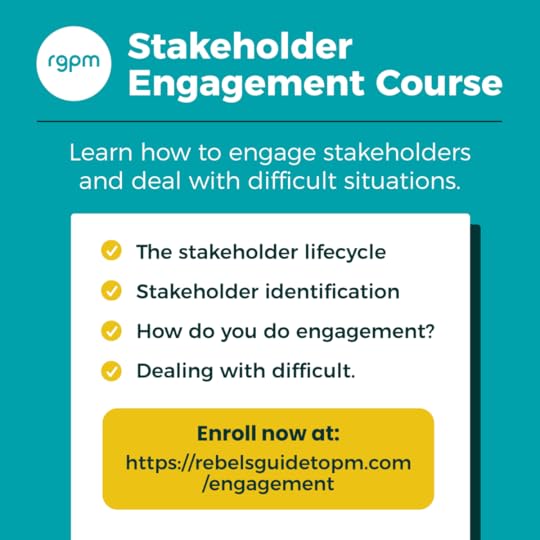
We’ll be covering:
Session 1:Stakeholder identification. You’ll create astakeholder register and assessment. You’ll get to know who your stakeholdersare and how they feel about your project.
Session 2:What does it mean to ‘do’ engagement? You’ll learn techniques that work to engage others effectively, so you can save time, build relationships and deliver the project results you need.
Session 3:Dealing with difficult. You’ll come away with techniques for diffusing conflict before it starts, learn how to deal with challenging situations and unavailable stakeholders.
The whole course is hugely practical, with real-life tips and strategies for making it easier to work with others. I have drawn on my official APM book, Engaging Stakeholders: How to harness people power, and professional practice to put together a learning experience designed to help you get the job done more quickly.
It’s $100 (with a VIP option that comes with a copy of the book and a group coaching call that is $197). If it’s something you’d like to do with me, then you can sign up here.
Count me in!Stakeholder management can be a bit messy and difficult. There is no magic wand I can wave to make all your people problems go away. If your project sponsor is horrible to work with, they probably still will be horrible, even if you’ve got amazing stakeholder engagement skills.
The thing that will be different is that you’ll know how to manage their difficult behaviour better.
The stakeholder workshop I’m teaching will give you a framework for doing exactly that. We’ll be plotting out who you need to involve, how to communicate with and engage them, and how to create feedback loops so you know what’s really important to them – and then you can do it.
Does it take more of your time to engagestakeholders properly? Yes.
Is it worth it in terms of project outcomesand your personal stress levels? Yes!
FAQWhat’s the time commitment?“Oh my goodness, I’m so excited! All of the materials have been so incredibly helpful. Thanks again for everything – I’m still sifting through all the extra resources and finding new, useful ideas!”
Leah, past student
3 hours, split into 3 sessions. One hour per day over 3 days, starting 7pm on Tuesday 21 February.
You don’t have to attend live. You can watch thereplays when it suits you. If you have questions and can’t join live, justemail me.
Is it right for me?We’regoing back to fundamentals, but getting to the more advanced stuff quitequickly. If you are literally just beginning in project management, then itmight not be for you, simply because you’ll get more out of it if you arealready working in a project environment with a real project to use the skillson.
It’snot an advanced negotiation or conflict management training either: if you aresuccessfully navigating office politics at senior levels and getting yourprojects in on time then I don’t think there’s much I can teach you!
I think the training is perfect for you if you want to make sure you’ve got the fundamentals right and you want practical tools, techniques and tips to gain credibility, handle stakeholders with different priorities and get your stakeholders engaged.
Can I claim PDUs?
Yes. You will get an attendance certificate. This course is about 3 hours of training so you can claim 3 PDUs against the Talent Triangle (claim the hours that you spend on the course materials – if you do the exercises and watch all the bonus training you can probably claim more). I am not a PMI ATP but that does not stop you claiming PDUs.
Can I claim the cost through my company?Yes,if they are prepared to fund it! I can issue an invoice/receipt for yourFinance team and take payment in a variety of ways.
I’m so excited to be offering this training and I hope you’ll join me in the workshop.
Sign up nowHope to see you on our Zoom calls!
This article first appeared at Rebel's Guide to Project Management
4 Unusual Reasons Why Stakeholder Management Is Important
Because we need people to get the project work done.
However, stakeholder management is a very narrow way of looking at how we work with people on projects to achieve a common goal. A better question would be, “Why is stakeholder engagement important?”
Let’s park that for the moment. I have a whole pack of information on stakeholder engagement on projects so for now, let’s focus on what’s commonly taught in project management courses, and look at stakeholder management.
What is stakeholder management?All projects have stakeholders, even the very smallest initiatives. The major reason that most project management approaches give for doing stakeholder management is that it helps you understand more about the people who will be affected by the project.
That information then enables you to plan communication and engagement strategies to head off any problems while you adhere to the principles of stakeholder management.
You know the drill – map influence and interest, then work to try to move any negative stakeholders into the quadrant where they should be through interesting communication approaches and stressing the project benefits for them.
However, there are other reasons for doing stakeholder management. Richard Newton, in his book, The Project Management Book, sets out another 4 benefits of stakeholder management. Here they are.
 1. Free Resources
1. Free Resources
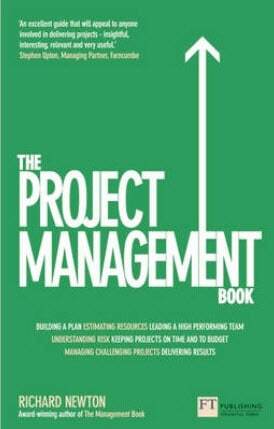 One of my favourite project management books
One of my favourite project management books“Proactive stakeholders effectively provide an extended team of additional resources (for free!),” he writes.
You can involve your stakeholders in any number of project tasks and delegate all kinds of things to them.
Want to do a presentation to Marketing but don’t have the time? Ask your most engaged Marketing stakeholder to do it for you. Need some help with the project budget? Get an enthusiastic stakeholder from Finance to talk you through it.
Tap into their skills and interest in the project. Anything from attending meetings, drafting communications, and carrying out other stakeholder engagement activities with their peers is fair game.
2. Reduce and Uncover Risk“Good stakeholder management reduces some risks and makes other risks, which may otherwise by unnoticed, transparent,” Newton says.
The more you engage your stakeholders, the more you can minimize some risks, like poor take up when a new piece of software is launched for internal use.
Your stakeholders can also help you identify new risks. The more you talk to them, the more you’ll find out about what else is going on that could potentially impact your project.
 3. Increase the Perception of Success
3. Increase the Perception of Success“Irrespective of actual project outcome, stakeholders who have been engaged and whose expectations have been managed are far likelier to perceive a project as a success than those who have been ignored,” writes Newton.
We all want our projects to be a success, don’t we? So it pays to engage with the right stakeholders all the way through the project, especially if it changes how they feel about the project at the end.
Projects don’t always deliver exactly what they set out to, so managing stakeholder engagements over the duration of the project is one way to help stakeholders adapt their expectations to what is realistic for delivery.
Read next: The Definitive Guide to Project Success Criteria
4. Easier Project Closure“It eases benefits realization and the transition phase at the end of a project when deliverables are handed over to their owners,” Newton says.
This is very true – it is far easier to hand over deliverables to someone who knows a bit about them than to someone who is hearing about the project for the first time. The more you work with your stakeholders during the project, the more prepared they and their teams will be to receive the deliverables.
They are also less likely to reject deliverables for not meeting their standards, as they will have been involved in the production, testing, and checking of deliverables up to this point. There won’t be any surprises as they’ve seen the process the whole way through.
Read my full review of Richard Newton’s book.
This article first appeared at Rebel's Guide to Project Management
February 12, 2023
Why Don’t 50% of People Do Stakeholder Engagement?
I ran a survey about stakeholder management (thanks, by the way, if you were one of the people who filled it out) and the results surprised me. I have done a bit of analysis on the results and I wanted to share what I know so far with you.
The biggest reason we do stakeholder engagement activities on projects is because they help us get the resources we need for the project.
But what stops us from engaging stakeholders the way we would want to, if we had all the time in the world, and all the resources?
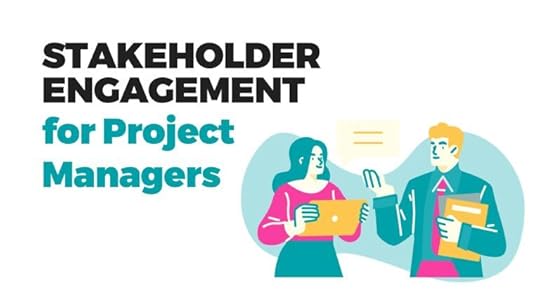 Join the February 2023 Stakeholder Engagement training
Join the February 2023 Stakeholder Engagement trainingLearn how to identify who to work with, deal with difficult situations and engage others in a way that saves time, builds relationships and gets the project results you want.
Click to learn more!
The main blockers to engaging stakeholders successfully are, according to the survey results:
Not having enough time (33%)Not having management support (28%)Not having the right templates (18%)Not knowing what to do (15%)A further 6% of respondents had other reasons for struggling to work with stakeholders the way they knew they could.
The chart below shows how these results break down.
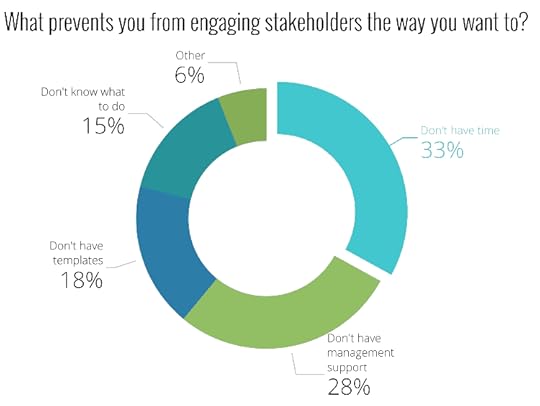 Knowing what to do and how to do it is crucial
Knowing what to do and how to do it is crucialOne in three people feel like they can’t manage their stakeholder relationships because they don’t know what to do or they don’t have the templates to help them.
I know what that’s like. I work as a project manager, I run my own business around the edges of that, and I have a young family. Time, and the energy to create documents from scratch when no one much seems to care, are things I don’t have.
I have had my ups and downs with stakeholder engagement. For a start, when I began managing projects it was all about ‘managing’ stakeholders. It took me a long time to work that you can’t manage people into being supportive about your project. It just doesn’t work.
They have to want you to be successful, which is where securing management support comes in.
Successful stakeholder engagement means understanding what people want out of the project, how they feel about it, how that changes over time. And it requires regular check ins and planning.
Learn new ways of working with stakeholdersOver time, I’ve developed ways to work with my stakeholders that doesn’t feel cheesy or forced and that works for me. One of the first things I do on any new project is create my plan of action for uncovering stakeholders and understanding their motivations.
After all, it’s people who get projects done (or stopped). Not processes or documents.
Having said that, processes and documents can really help! Especially if you are pressed for time or don’t know exactly where to start.
 Sign up for the stakeholder training Stakeholder engagement made easy
Sign up for the stakeholder training Stakeholder engagement made easyIf you’re one of the 33% who don’t know what to do or don’t have the templates to do it, then I have a special announcement for you.
Starting 21 February 2023, I’m teaching a stakeholder engagement masterclass. It runs over 3 evenings (UK time) and it covers everything from the basics of how to work out who your stakeholders are to advanced ways of prioritizing your time so everyone get the right amount of attention.
And it answers the difficult questions: what does engaging others actually look like? What do you do to engage them?
The training, and the associated templates you can download to turn your new knowledge into practical action back at the workplace, will help you:
Identify who needs to be involved in your project.Work out how they are going to react to your project.Create an engagement plan to ensure that you can shift the behavior or attitudes of any stakeholders who appear negative, and ensure that the team maintains the positive outlook of any stakeholders who are supportive.Look professional and prepared when working with stakeholders.Review how your engagement activities are going so you can switch out your strategies if you need to.If you’ve ever felt like there has to be a better, faster way to plan your stakeholder engagement then you won’t want to miss this!
Learn more about the trainingThis article first appeared at Rebel's Guide to Project Management
February 8, 2023
Stakeholder Engagement Essentials You Always Wanted To Know (Book Review)
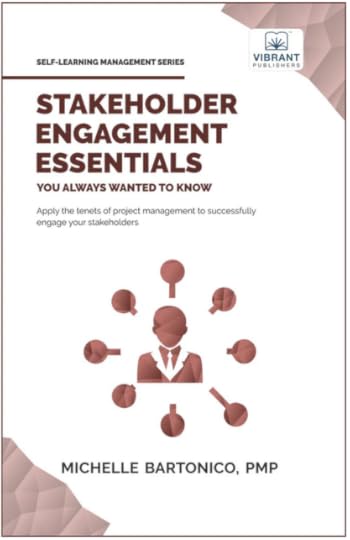 The book’s cover (see on Amazon)
The book’s cover (see on Amazon)Stakeholder Engagement Essentials You Always Wanted To Know by Michelle Bartonico (Vibrant Publishers, 2023) is a book about working with others on projects.
It’s goal is to help you “learn strategies and techniques to balance the tenets of project management with the realities of human dynamics” – something I’m very keen to make sure happens in our practice as project professionals.
There are two things I think worth pointing out about this book:
The book leans heavily on PMI ways of workingFirst, although it is very much grounded in reality and practical skills, it also heavily leans on A Guide to the Project Management Body of Knowledge (PMBOK® Guide). For example, there is a section early on that outlines the differences between the 6th and 7th editions of the Guide, which really isn’t relevant for anyone who is not familiar with PMI approaches or inclined to study for the PMP® exam in the future.
I feel the focus on what the PMBOK® Guide says makes the book better for people who work in organizations that draw their methods from the PMI ways of working.
(For the avoidance of doubt, I like the PMBOK® Guide, it’s a good read.)
Essential read A Guide to the Project Management Body of Knowledge (PMBOK® Guide) £41.00A Guide to the Project Management Body of Knowledge (also known as the PMBOK® Guide -- 7th Edition) is core reading as prep for PMI exams.
It's also a useful overview of ways of working, and this version includes The Standard for Project Managers too.
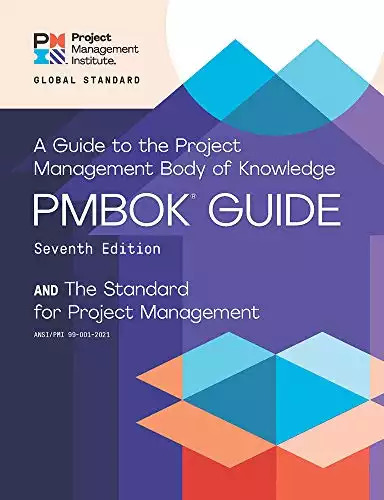 See on Amazon We earn a commission if you click this link and make a purchase, at no additional cost to you #ad 02/08/2023 09:31 am GMT
See on Amazon We earn a commission if you click this link and make a purchase, at no additional cost to you #ad 02/08/2023 09:31 am GMT If you work in an organization that uses a different methodology, you obviously can still learn from the book and apply the core skills, but it grates a little to read something that is so grounded in one particular way of working.
The author does make the point that the PMBOK® Guide is not the only body of knowledge or approach out there, but it comes up a lot.
So, the first think I’d conclude about this book is that it is best for people who are aware of and likely to be working in an environment where PMI is a common way of approaching work.
And that brings me to the second point.
It’s aimed at beginnersIf you have some experience working in projects, then I would hazard a guess that this book is not for you. The publisher says it provides “foundational essentials” and that it is “part of the Self-Learning Management Series designed to help students, managers, career switchers, and entrepreneurs learn essential management lessons.”
We need books like this, that provide accessible, realistic entry points for people starting out in their careers. Stakeholder Engagement Essentials is clear, precise, and basically a playbook for doing the project management aspects of working with others.
Stakeholder Engagement Essentials covers:
Stakeholder identificationMapping and analysisCreating a stakeholder engagement plan and looping project communications into thatWorking through challenging situations.These are all core points, but I would suggest that if you have 5+ years of leading projects, then you can probably put together a power/influence grid and a stakeholder register without thinking about it too much.
If you are new to project management, new to leading project teams – even if you have a lot of other, related business experience in a different field – then this will be relevant to you. Stakeholder engagement on projects is specific and different to the way that you worked with other teams in an operational or line management role, so it is worth reviewing ‘the basics’ so you have a solid understanding of how to make them work.
Practical activities and fun cartoonsThe book also includes activities at the end of each chapter, which are designed to help you put the learning into practice. You can think of the book as a workbook – something you can keep on the desk and come back to as and when you encounter new situations on your projects.
I thought the book was OK for the audience it is aimed at, and it’s great to see more authors focusing on this most important aspect of doing the work of project delivery.
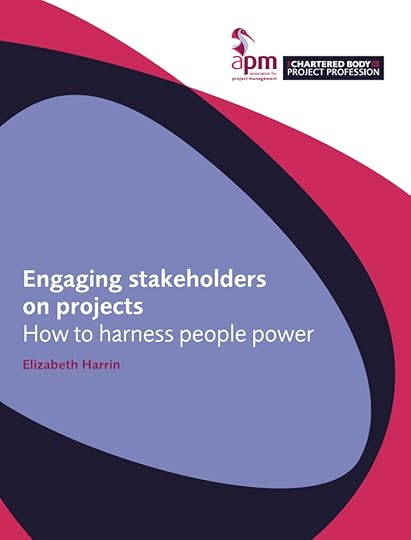 Full disclosure!
Full disclosure!I am also the author of a book on stakeholder management: Engaging Stakeholders on Projects: How to harness people power (published by APM), so I am probably not the intended audience for Stakeholder Engagement Essentials!
My book is aligned to the APM Body of Knowledge 7th Edition but does not reference it extensively, and if you can get over the incredibly boring cover, inside it is packed with advanced strategies, tools and techniques for engaging others in project delivery.
This article first appeared at Rebel's Guide to Project Management
February 1, 2023
Office Timeline Pro+ Review [2023]
Office Timeline is a powerful PowerPoint plugin for creating professional timelines and roadmaps.
The Pro+ edition is aimed specifically at project managers needing to create timeline slides for executive briefings and project reviews.
In this review of Office Timeline Pro+, I’ll share the pros and cons that I found from using this tool.
Table of ContentsSummaryWhat is Office Timeline?What's new in the Pro+ Edition?How to get started with Office TimelinePro+ FeaturesWhat is a multi-level swimlane?More features comingOther changes in the Pro+ editionStyling your timelineImporting from MS Project Getting startedProsConsSummaryFAQIs Office Timeline Pro+ a Microsoft product?How do I get to Office Timeline Pro/Pro+?SummaryProduct: Office Timeline
Pricing:
Basic: $59 per year
Pro: $99 per year
Pro+: $149 per year
There is also a limited version that is available free.
Hosting model: The ‘main’ version is a Windows plugin, but there is a cloud version which lets you run the tool in the browser (a solution for Office Timeline for Mac users).
Languages: The interface is in English but you can change the language on the timeline to show months/weekday names etc in any standard Office language.
Website: https://www.officetimeline.com
Summary review of Office Timeline: Office Timeline is a simple way of creating timelines for your project from inside PowerPoint or your browser. It’s your answer to visually communicating key dates and project tasks in a format that feels familiar. A must-have app for managers wanting a fast way to make attractive timelines. What is Office Timeline?Office Timeline is a Microsoft Office timeline add in for PowerPoint that helps you make slides people actually want to read. It’s a way of creating professional visual timelines in a fraction of the time it would take you to manually set those up in PowerPoint.
And, you can ditch your reliance on the ugly Smart Art tools!
The PowerPoint plugin has lots of features, such as marking key dates, swimlanes for different workstreams, and milestones. You can style the timeline to match your organization’s brand colors.
What’s new in the Pro+ Edition?The Pro+ edition has features that make it even more relevant to project teams.
You can:
Add sub-swimlanesAdd multiple timeline scalesUse new sub-swimlane templates.Basically, if your project schedule is complicated with the need to display different workstreams or different time periods, then Pro+ has the flexibility you need.

 How to get started with Office Timeline
How to get started with Office TimelineOnce you’ve bought your licence, download the plugin and run the file to install it.
When PowerPoint next opens, you’ll see the following screen. Copy/paste the Office Timeline product key you were sent in your activation email.

The wizard will walk you through a few things to know so you can get started quickly. There are also demo slides you’ll see so you can get used to how to create the timeline before you start messing with your Project Board deck.
Pro+ FeaturesSo what’s the benefit of Pro+?
Here’s a breakdown of the main features that you get with the different editions.
FeatureBasicProPro+Create swimlanesNoYesYesAdd milestones in swimlanesNoYesYesCreate sub-swimlanesNoNoYesShow multiple timescales on the same timelineNoNoYesThere are some other features as well, but the ability to craft your timeline exactly how you want it is the main benefit for professional project managers.
Note: Office Timeline Free edition has limitations in the amount of data you can add, but it’s still enough to get you started and so you can check out the tool to see if it is a good fit for what you need.
The Office Timeline cost of each of these options is very reasonable: ask your PMO to fund a licence or two for the key users in the team. You will need one licence per person.
What is a multi-level swimlane?A swimlane is simply a graphical way of grouping tasks on a chart. You color-code the background and then pop in the tasks.
The timeline below shows a schedule using single swimlanes. As you can see, each block has one set of tasks within it.

The timeline below uses sub-swimlanes. For a timeline maker to be truly useful in a project environment, this feature is a must-have.

It looks far more complicated but it’s still easy to understand. There are three main sections:
Key datesEngineeringInfrastructure.Each of those is broken down into different strands, so there is a workstream for Engineering App Services and another one for Engineering Design. You can see that within a particular workstream, this feature would be really important, and makes for a cleaner presentation of the schedule.
This timeline also uses multiple timebands. At the top you can see that there are three grey timebands, one for year, one for quarter and one for month. That helps all kinds of stakeholders to orientate themselves as to where they are and what’s happening when.
Milestones get more context than before.
More features comingWhen I spoke to the Office Timeline team, I was impressed by their commitment to constantly releasing new features. The most impressive thing is that they are actually listening to the project management community and building the functionality we need.
For example, that strap line: “Give stakeholders program slides they will actually read.”
I was told that came from feedback from a ‘real’ project manager. The team talk about the new stuff in the pipeline and the features they have built casually referencing their market research and feedback from customers. They are really listening, and I think that’s important for the future of the tool.
Other changes in the Pro+ editionAnother thing that the team behind Office Timeline has done is to restyle the ribbon in PowerPoint to make things simpler. For example, in the timeline view you can add tasks, milestones and swimlanes direct from that view.
You can still use the data view and/or import data, but now you don’t have to.
As you move items on the timeline graphically, it reflects in the data view as well. Drag and drop makes editing your timeline very easy. It’s a drag and drop visual editor and it’s really good.
 Add tasks, milestones and swimlanes direct from the timeline view
Add tasks, milestones and swimlanes direct from the timeline viewOnce you’ve added the tasks, milestones and swimlanes required, click Create and it creates a slide with the timeline on it. Then the fun begins!
Styling your timelineYou can edit the timescale settings and now there are 3 options for scales: top tier, middle tier and bottom tier (although you don’t have to use all three). This means you can set separate timescales.
For example, if you have a project that is going to run for years, you can have a big long annual scale at the top. Then if you need to identify an exact point in time e.g. a milestone for a day that helps people place moments in time on the project, you can do that with another timeband. Otherwise it might look like you have tasks that go on for years and it’s hard for people to orientate activities within a year.
Tip: Rotate the titles of swimlanes to make them smaller columns! It’s so easy to make the schedule look good, which is important to help get the message across.
You can apply different templates to make the look and feel fit what you want. If none of the pre-created styles work for your brand, create your own timeline template with your own shapes for milestones etc and then save as a template to use in the future.
Importing from MS ProjectLet’s say you already have a schedule in MS Project. You don’t really want to have to create another timeline by hand, copying and pasting dates.
Well, you don’t have to!
The Import wizard is really simple to use. Browse to your file. The wizard will help you select the data for the slide.
Tip: Add a new column to your Microsoft Project plan that includes the swimlane/sub-swimlane title so Office Timeline knows where to map the task to. You don’t have to do this, but it will make styling your timeline a lot easier.
If you don’t have correctly-named columns in MS Project, you’ll be prompted to help the Office Timeline wizard map the right columns.
As this is for a project presentation or report, you won’t want to bring in all 100+ lines of your giant schedule. Select what tasks you want to bring over. To make my life easier, I typically already create an exec summary at the top of my MS Project plan. I’d only select those tasks.
I like the fact that the team recognize that this is not a tool that would necessarily replace Microsoft Project or the scheduling tool of your choice. Yes, you can build out a simple project schedule in it, but it’s really designed for pretty presentation of your data and reporting: executive summaries.
Next month, hit the Sync button and then the PowerPoint timeline will review the file and look for updates to the file.
Tip: Don’t change the location or file name of your original import data source (e.g. .mpp or .xlsx) so Office Timeline can go back and check for changes.
Getting startedDon’t worry if you’ve never used it before or can’t quite see how your huge schedule would possibly condense down into a single slide.
Sometimes it helps to start from someone else’s plan to give you the ideas of what is possible. Open a template project with dummy data and then put in your own. There are plenty of sources of inspiration built into the tool and also in the Resources section on the website.
It’s very intuitive once you get going, and the online help is good enough to get you unstuck.
Tip: Always make sure you have the latest version. Download the latest build on the site, and make a diary note to check back every six months to grab any improvements from the Updates page on the website.
ProsIt’s integrated within PowerPoint and has the feel of PowerPoint. You don’t have the impression you are working with a different toolYou can have milestones at the top or bottom on the barGreat for big picture communications and helping stakeholders understand the complexity of the workGreat for expectation settingEvery Project Board deck needs a timeline like this!ConsUpdating the colors can be a bit time consuming. If you have favorite or brand colors, you should first save them as Theme colors in PowerPoint so they show up in your Office Timeline color options. Also, you can use the “Apply to all” button to apply color changes to several elements at once.It takes a bit of formatting to get the set up exactly as you want it, the first time. There are a lot of options and styling choices to consider and use – and you will want to test them all out instead of relying on the templates.There is still no option to add task dependencies.SummaryOffice Timeline Pro+ doesn’t replace your complex project data software, but does mean that stakeholders don’t have to look at it!
Instead, they can look at a simplified, easy to understand Gantt chart on a slide.
Let’s face it: while many PPM tools offer dashboards and executive reports, the stakeholders you work with might still prefer information on a slide. Office Timeline Pro+ gives you a huge range of professional-looking options to make that happen.
Make your communications shine and help stakeholders understand what’s happening with a clear project timeline!
FAQIs Office Timeline Pro+ a Microsoft product?No. Office Timeline is not owned by Microsoft but is a fully compatible plugin for Microsoft PowerPoint.
How do I get to Office Timeline Pro/Pro+?Once you have installed the plugin, the menu options for the timeline creator will be in the PowerPoint ribbon at the top of your screen. You access Office Timeline direct from the PowerPoint menus.
Pin for later reading
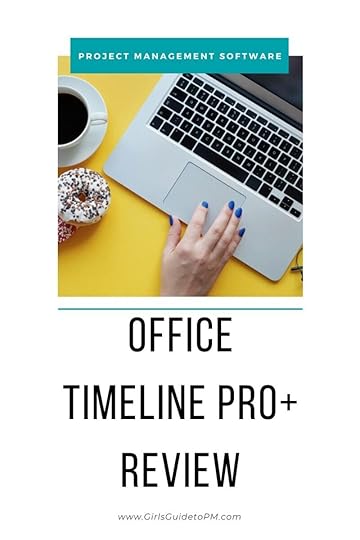
This article first appeared at Rebel's Guide to Project Management
January 31, 2023
How To Make 2023 A Successful Year for Your Projects
Would you like to make 2023 a successful year for your projects? I’m sure you do. Especially as the last few years haven’t been exactly stellar years for many of us!
But what does it take to get there?
A while back, I asked project management experts what we should be aware of as we go into the new year to achieve their most successful year ever?
And this article is a summary of what they replied.
The collected wisdom in their answers is incredibly valuable. I’m sure you take away tips and ideas for making this your best year yet managing projects at work.
It’s a lot to read, so here are some spoilers drawn from common themes I heard time and time again in the interviews:
Agile: if you don’t know enough about it, you need to start learning.Soft skills, interpersonal skills, emotional intelligence: whatever you call it, these are crucial and stakeholder management and communication come out top time and time again.Leadership: ethical, authentic leadership is what helps get work done and set you apart from your peers.Ready? Let’s jump in. And in no particular order we start with:
Mark Phillips Mark Phillips
Mark PhillipsHigh performing teams are motivated by an exceptional vision. Work with your stakeholders to craft a clear and powerful vision for your project or your particular phase of the project. The vision becomes a touchstone for difficult discussions with stakeholders, a path to unity for all project participants and a guide post for decision making with your team throughout the project.
These past few years have seen an incredible evolution in the way software is built. In these next years, we’re going to see a new wave of what software can do with the growing capabilities of machine learning, artificial intelligence and data pipelines across enterprises.
Mark Phillips runs a consultancy focused on high performing projects. He is the author of Reinventing Communication by Routledge, a book on how to design, lead and manage high performing projects.
You can see Mark’s book, and all the other experts’ books on Amazon here.
Ranjit Sidhu Ranjit Sidhu
Ranjit SidhuAs we go into next year, you should be aware that self-care and wellbeing are trends worth promoting not only because they feel good, but because they lead to better productivity and happier people.
The extension of self-care is caring for others, also crucial for project management and change management. Connecting with people, collaborating, partnering, so you can inspire enthusiasm, overcome resistance, and help make change happen.
Going with the flow seems to go against years of traditional project management thinking, but we have found it easier to do by focusing on our bigger purpose and values, all while remaining agile day-to-day so we can adapt quickly. It’s how we can help people and organisations adapt in fast-changing times.
Ranjit Sidhu, Managing Director of ChangeQuest, is a recognised authority on change management and behavioural skills. Find her on Twitter.
Ben Aston Ben Aston
Ben AstonIt might seem like we could let our increasingly agile, multi-disciplinary, and highly collaborative teams just get on with it. You’d be forgiven for thinking you’ll be fine if you just go along for the ride as a glorified project administrator.
But we can do better. Successful project managers will be those that embrace the mantle of leadership.
This starts with a solid understanding of success, beyond cost, schedule and scope. Think about how you’re delivering on the project’s strategic goals and how you’ll be able to demonstrate the ROI that your stakeholders need to look good. Remember your stakeholders’ tacit goals too — you’re in the rockstar-making business. Make them look good, and in turn, they’ll make you look good.
When you know what success looks like you can inspire, motivate and lead the team with a clear unifying vision. Help your team get hold of the vision and understand why they should care and how they can take ownership to be meaningfully involved.
Throughout the project, leadership is simple: you serve your team. Project leadership is about how far you can advance those on your team to be the best version of themselves. Practically that means asking yourself how are you going to make your team’s life better today? A well-documented plan? Proper briefs? Donuts? Be the person that moves mountains for them. And they’ll repay you in kind.
Ben Aston runs the blog The Digital Project Manager, the weekly Digital Project Manager podcast, and is a digital project manager in real life too.
 John Estrella
John Estrella John Estrella
John EstrellaWith the release of the Agile Practice Guide along with the PMBOK® Guide Seventh Edition, we can’t ignore PMI’s direction to incorporate adaptive life cycles such as agile, iterative or incremental life cycles into project and development life cycles.
External factors around projects are constantly changing at a breakneck speed which makes it challenging to definitively control the outcome without frequent course correction.
A Guide to the Project Management Body of Knowledge (PMBOK® Guide) 7th EditionA Guide to the Project Management Body of Knowledge (also known as the PMBOK® Guide -- 7th Edition) is core reading as prep for PMI exams.
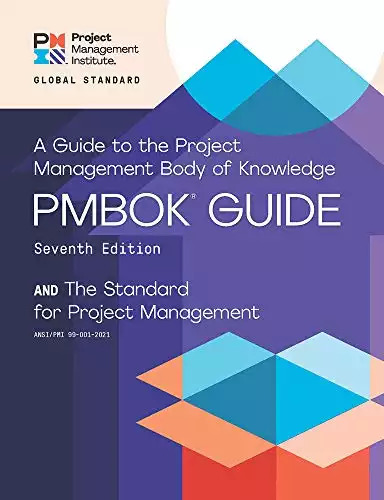 Buy Now We earn a commission if you click this link and make a purchase, at no additional cost to you #ad
Buy Now We earn a commission if you click this link and make a purchase, at no additional cost to you #ad PMI’s Project Management Professional (PMP)® credential will continue to thrive. It can serve as a baseline, but most project managers ought to layer some sort of agile certification on top of it. Brain Sensei’s Complete PMP® Exam Prep course can be taken anytime and anywhere. Its unique storytelling approaching using a Japanese female samurai makes learning project management and preparing for the PMP exam so much fun!
John A. Estrella, PhD, CMC, PMP, is Co-Founder and President of Agilitek Corporation and Brain Sensei, Inc. John is the co-author of Agile Project Management for Mobile Application Development.
Mike Clayton Mike Clayton
Mike ClaytonFocus hard on your communication with stakeholders. Whatever your level of commitment to this vital task, please review how you can do even better. This may be by adopting a new tool or approach, learning some new skills in listening, influence, or negotiation, or maybe simply allocating more time to it.
Dr Mike Clayton is one of the most in-demand project management trainers in the UK. He is author of 13 best-selling books, including four about project management. He runs the online training site, OnlinePMCourses.com.
Helena Lui Helena Lui
Helena LuiAgile project management is on the rise. Learning the different methodologies in Agile (e.g. XP, scrum, lean, etc.) and how to apply it can be extremely beneficial: that’s what I would advise for people wanting to have a year of managing successful projects.
Helena Liu, PMP, is a project manager and the founder of ExamsPM, an organisation that helps PMP-aspirants get certified.
Sarah Parsons Sarah Parsons
Sarah ParsonsFor a successful year my number one piece of advice is to do the basics well. Communicate thoroughly, be consistent and remember that your role is focused on both getting the work done and supporting the team.
This isn’t ground-breaking, but a surprising number of project managers don’t do the basics well.
If someone emails you, email them back. If you owe someone information, or have promised to deliver something, deliver it. If you said you’d have an answer and you don’t, communicate that early, clearly and with a solution in mind.
Consistently do the basics of your job well and you will stand out from the majority of your peers.
Sarah Parsons, MBA and founder of StrategySarah.com, helps busy professionals make it easier to get life and business done.
Bill Dow
With the likes of PowerBI and Tableau taking off around dashboard and reporting, I think our executives and leadership are going to want to see more project data real time.
Bill Dow, PMP, is a recognised expert in developing and managing Project Management Offices (PMOs.) He is co-author several comprehensive books, and runs regular webinars which you can find out about on his Facebook page.
Jonathan Norman Jonathan Norman
Jonathan NormanI suspect that we may be faced with increasing political turbulence, which may have a significant impact on your organisation or the projects that you are running.
On the personal advice front, I am very much looking forward to adding events to our knowledge sharing activities within the Major Projects Community. The lesson I need to remember is that, whilst experimenting is an integral part of innovation, the most successful programmes are those that recognise the ongoing needs of business-as-usual and balance the tried and tested with the new.
Jonathan Norman is the Knowledge Manager for the Major Projects Knowledge Hub in the UK.
Find out what a Knowledge Manager is.
Monica Borrell Monica Borrell
Monica BorrellI am noticing two trends. First, virtual teams are becoming the norm. Second, the use of lean and agile tools and methodologies beyond IT, software and manufacturing. For example, Cardsmith has customers using Kanban to manage bookkeeping and accounting work.
These two trends taken together mean that visual, collaborative tools are becoming more important to teams. Visual, lean tools that truly engage all team members are going to become essential.
Collaboration with context is my current mantra. The context is the visual board in whatever configuration best suits the particular project and team.
Monica Borrell, PMP, is the CEO and co-founder of Cardsmith, a visual planning, communication, and project management tool.
Colin Ellis Colin Ellis
Colin EllisThe secret to continual project success lies in the ability to build great teams. Teams that understand what it means to be the best versions of themselves, how to hold each other to account, how to behave and communicate.
Teams that know how to challenge each other, to work autonomously to deliver great products and that take responsibility when others are struggling.
Teams that take the time to celebrate success, to socialise and that put effort into relentlessly developing themselves and the way that they do things.
Empathy lies at the heart of great teams and project managers should be role models for this, putting time and effort into demonstrating the behaviours expected of others and building relationships so that bonds can be built and maintained.
Project managers, and scrum masters for that matter, that wish to stay
relevant for years to come need to develop their emotional intelligence and team building skills.
Colin Ellis is an award-winning international project management speaker and trainer. He is the author of two project management books: The Conscious Project Leader and The Project Rots from the Head. Find out more about Colin’s work at colindellis.com
 Soma Bhattacharya
Soma BhattacharyaAgile has been the trendiest thing for a while now and recently we have seen Agile considerably embedded in the project management domain, globally.
I think the goal for every project manager should be to upgrade their certification to an Agile Project Management Certification or simply ensure that you understand how Agile works, the terminologies and the different frameworks in it.
Soma Bhattacharya is the blogger behind Stepping into PM, and an Agile consultant. You can follow her on Twitter here.
Vasily Klimko Vasily Klimko
Vasily KlimkoAs collaboration software evolves, project managers will be able to further expand their scope for talent. Highly talented freelancers no longer need to travel into a major metropolis to find work in their industry.
What I think we’ll see next year is that tools will be developed that will allow these freelancers to take their credibility with them across projects, allowing potential employers to judge work and merit based on data and results, not just word of mouth.
I see a future where Project Managers will be able to reference a talent hub to see how freelancers have delivered work in the past as well as view client feedback.
Vasily Klimko is CMO of Cerri.
Brett Harned Brett Harned
Brett HarnedThe best way to make next year your most successful year yet is to plan for it! It sounds like such a PM thing to say, but it’s true. As PMs, we so often are focused on other people’s (team members, stakeholders) goals that we often fail to think of ourselves.
We love lists, so get to it: you know you’ll feel great if you have a roadmap for the year and you can meet milestones regularly. That, in and of itself, will make the year a success.
Brett Harned is the director of Education at TeamGantt, author of Project Management for Humans, and the founder of the Digital PM Summit.
 Nicole Nader
Nicole Nader Nicole Nader
Nicole NaderI believe that the fastest and most effective way to make my team the best team is for me to be my best self.
People respond instinctively to body language, words, tone and enthusiasm: if my verbal and physical cues indicate that I am uninspired and unmotivated, then why would I expect my team to have pep in their step and a passion for what they are doing?
For me, my best self starts by prioritising the routines that bring about my best performance. This means putting my health (physical and mental), fitness and family first, even when everyone else is throwing their own problems in my direction. It’s only when I have this in hand that I can really start to relate to my team on a personal level, find out what makes them tick, and truly lead by example.
Nicole Nader was a Board member of the Australian Institute of Project Management in 2018. Find her on Twitter here.
 Andy Kaufman
Andy Kaufman Andy Kaufman
Andy KaufmanTo be more successful in the coming year, the most important thing you can do is to learn how to calculate critical path by hand.
Hah! That’s not even remotely true! For most project managers, your success in the new year has less to do with your technical project management skills. Rather, as with most years, your ability to thrive has much more to do with your ability to lead and influence.
As I work with project managers around the world, increasingly there’s one success trait that I find could use a tune-up. In a word, it’s assertiveness.
Here’s what I wish for you as you start a new year. Dial up your assertiveness, even if just a little. Speak up a little more often. Lean in a little more to the opportunities before you. Try some new things you may have checked out on.
Andy Kaufman , PMP, is an international speaker, author, and executive coach at the Institute for Leadership Excellence & Development Inc. He is the author of Navigating the Winds of Change: Staying on Course in Business and Life and Shining the Light on the Secret. He is also the host of The People and Projects Podcast.
Louise Worsley Louise Worsley
Louise WorsleyAs a project coach, I get many opportunities to ask the question, “What did you learn from most over the last few years?” So far no one has ever answered; “There was this great course…”
Most adult learning comes from relevant experience: challenges faced on a project, interactions with peers, or opportunities which force reflection upon and make sense of our experience.
Creating your personal learning environment is more than just responding to immediate needs in the workplace. It’s a way of life, a way of becoming a modern professional learner to meet today’s ever changing challenges.
Louise Worsley is a PPPM consultant and a visiting lecturer in project management at The University of Cape Town. She is also the author of Stakeholder-led Project Management: Changing the way we manage projects.
Robin Burk Robin Burk
Robin BurkThe effective project manager has a way to deal with unexpected change and uncertainty. She builds resilience into her team, her approach and her response to unanticipated events.
Resilience means being able to absorb unexpected events and changes while still reaching your goals. The effective project manager can do even more: she can build a team that is so resilient they are antifragile and thrive on change. And that will be increasingly important.
Dr. Robin Burk has extensive project, program and executive management experience in rapidly changing tech markets. She is the managing director of Analytic Decisions2 LLC and author of Check Your Connections: How to Thrive in an Uncertain World.
Ray McKenzie Ray McKenzie
Ray McKenzieThere’s an increase in distributed teams, personnel, and abilities within organisations. The ability to capitalise on the strengths of distributed teams is in project management.
As distributed teams continue to evolve in the workplace and for companies, it is extremely important to select the right tools to ensure a project is completed successfully. Project managers should utilise tools that provide visibility for the entire team, provide clear structure for projects, embrace an agile or waterfall methodology, and those that encourage collaboration.
This can be through one suite of tools or two tools that provide project management and collaboration. I recommend the use of newer SaaS tools allowing all project team members to participate, provide feedback, and work towards successful projects.
Ray McKenzie, CSM, is Founder and Principal of Red Beach Advisors, a management and business consultant group. Find him on Twitter.
Cristian Rennella Cristian Rennella
Cristian RennellaFocus on decreasing interruptions for your team. Also, aim to have fewer goals. Because when you define your goals, remember that the difference is not in quantity but in quality.
Instead of 5 goals define only 3, the most important. Work on them with dedication and excellence.
The difference in your work is in the depth that you can give to each topic. That way you will achieve perfection in your profession and success in the long term.
Eng. Cristian Rennella is a project manager and cofounder of elMejorTrato.com, a financial comparison site based in South America.
Scott Perry Scott Perry
Scott PerryMost of my early career, my main approach to managing my projects could be described as being mostly “administrative” or “coordinating” in nature. My focus was probably too much on things like reporting, data, status meetings, and reaching schedule dates no matter what – sometimes at the expense of quality!
These things are important, yes. But what I’m finding now – and am more convinced of – is that a key ingredient in being an effective project manager is being an effective leader.
A good project manager is at his or her core a good leader! They know how to influence, motivate, create and communicate a vision. They have soft skills, can lead up and down, and can adequately manage organizational politics so that their project can advance as planned.
Scott Perry, PMP, is a project manager based in North Carolina, USA. He is also a baseball fan and runs the site CatchersHome.com.
Joe Pusz Joe Pusz
Joe PuszProject managers should be aware of how important soft skills are to ensure a successful career. Often times PMs get caught up in the Agile vs Waterfall debate, or is the schedule perfect, or are all the words spelled correctly in a requirements document.
All of those are important, but not as much as learning to be an effective communicator, team builder, negotiator, and motivator. To make next year a successful year I’d recommend project managers focus on these soft skills to become better leaders.
Joe Pusz is President of The PMO Squad, a project management consulting firm. He has 20+ years as a project manager and PMO leader. Find out more or participate in his Veterans mentoring scheme on the website.
Leigh Espy Leigh Espy
Leigh EspyAgile practices are increasing in popularity. Even if your team is not adopting full Agile methodology, there are beneficial Agile practices teams can use.
The retrospective is an easy one to use to help the team continuously improve. Do this by getting team feedback at various stages on what the team could do better. You can then incorporate any suggested improvements during the project rather than waiting for the information from a “lessons learned” activity at the very end.
Leigh Espy, PMP, SPC, CSM, is an experienced IT project manager and coach. She also writes the blog Project Bliss and is author of Bad Meetings Happen to Good People: How to Run Meetings That Are Effective, Focused, and Produce Results.
Susanne Madsen Susanne Madsen
Susanne MadsenMore and more project managers are waking up to the fact that projects aren’t just about tasks and schedules, but also very much about people. But we still have a long way to go.
Everyone would like to be part of a high performing team, but too few managers and leaders put in the effort to create one.
I would encourage all project managers to be more mindful when they form a new project team, to properly engage people in the definition and planning stages and to take the time to explore what they expect of each other in terms of behaviours.
I would also encourage project managers to be more innovative. The world is developing at an unprecedented speed and to keep up we have to continuously look at how we can improve the products and services we deliver along with the tools and processes we use to deliver them.
To get better at improving and innovating it is imperative that project managers create a safe environment for the team to express their ideas and that they set time aside for unstructured thinking. If all they value is compliance and control they will kill innovation.
Susanne Madsen is an internationally recognised project leadership coach, trainer and consultant. She is the author of The Power of Project Leadership and The Project Management Coaching Workbook. Find her on Twitter.
Amy Hamilton Amy Hamilton
Amy HamiltonNext year will be a year for ethical and authentic leadership for project managers. Recent events in both the United States and the world have shown that scandals and sensationalism doesn’t work.
Project managers will need to not only have expert technical knowledge to include how to build a work breakdown structure or how to calculate earned value management, but soft skills on how to communicate. In IT project management, especially cybersecurity, technical team members are in demand and they know that they don’t have to work for an unethical or draconian project manager.
Emotional intelligence and understanding the needs of team members will be important to keep top quality team members on board. The newest edition of the PMI standards captures the increasing need for communication management for project success.
Amy Hamilton, PMP, CISM, is the author of The Project Manager: Life is a Project, TEDx speaker and IT project management expert.
Sarah Coleman Sarah Coleman
Sarah ColemanI would like to see PMs across industry sectors and geographies balancing their technical skills set with the behavioural and social skills set. There is an increasing awareness of the impact and importance of behavioural sciences as part of the design, planning and delivery of projects, programmes, portfolios and change.
I am particularly passionate about the need for project managers to comfortably influence without authority, moving easily around the organization between the C-suite and operational levels as well as across client and supplier organisations. This is a skill and part of the toolkit which every project professional needs in order to be that much more effective.
Sarah Coleman is founder of Business Evolution and is author of Organizational Change Explained and Project Leadership. She is a Visiting Fellow at University of Lincoln and Cranfield University.
Traci Duez Traci Duez
Traci DuezProject management used to be about DOING. In today’s global economy, resources have more options when it comes to employment. These resources want to work for people who are more than task masters. So, then the shift was on to LEADERSHIP.
Before someone can become a good leader, they must be a good SELF-LEADER. This is more about BEING than DOING. You see, you can’t BE a project manager. You can only be a human being who manages projects. The role you play is not the same as the person you are. You can always BE even if you don’t always DO the role.
Traci Duez is a leadership development specialist, author, speaker and the founder of Break Free Consulting. She has over 20 years of experience spanning medical technologist to project manager and executive consultant. She’s also the author of Breaking Free: Leading the Way.
 Jon Clay
Jon ClayNext year why not make sure you step outside of your comfort zone and do something that scares you every month? If you are scared then it means you are testing yourself.
You gain new skills and knowledge that will help you to excel in both your professional and personal life. I’ve been doing this for years and I never fail to be surprised at what I learn.
Jonathan Clay, PMP, MSP, is a past President of PMI UK Chapter and a project manager in the financial services industry.
Linky van der Merwe Linky van der Merwe
Linky van der MerweFor project managers to remain relevant in the world of project complexity, remote teams and continuous change, we would want to be strategic, flexible all-rounders with an ability to do creative thinking. This will come with support from PMO’s who can read the current business landscape and who will provide the necessary training to develop all project support personnel to support all types of projects.
The need for Lean thinking and developing an Agile mindset supporting the Agile values and principles in the way we work, has increased. With the demand for successful project delivery bigger than ever before, the emphasis has moved to the speed with which value (benefits) can be delivered to Business.
Although existing technical, leadership and other soft skills will remain relevant, the need for higher emotional intelligence will grow, not only for project leaders, but also for team members to become high performing teams.
Linky van der Merwe (PMP, PMI-ACP) is a project management consultant with experience in IT projects in various industries for 20 years. As the Founder of Virtual Project Consulting, she collects and shares project success stories from experienced project practitioners and she recommends comprehensive PM resources to help develop aspiring and existing project professionals.
Todd Williams Todd C. Williams
Todd C. WilliamsI am continually amazed at how many people refuse to be accountable.
To be sure, I am not simply talking to project managers. This is an issue with executives as much as with people in the immediate project team. Being accountable is not synonymous with a target for blame. Accountability entails making and delegate decisions. Accountability cannot be delegated; that is called scapegoating.
We teach our teams to be accountable by being accountable ourselves and holding our team members to being accountable to themselves. Breeding accountability in our superiors requires the same, but also takes the fortitude to hold superiors accountable through their peers and your relentless accounting of decisions. Regardless, it starts with you.
Todd C. Williams, PMP, is the author of Filling Execution Gaps and Rescue the Problem Project. He is an executive consultant with three decades of experience helping organizations connect strategy to successful projects. Find him on Twitter and Facebook.
Gary Lloyd Gary Lloyd
Gary LloydWhen projects get tough, it’s relationships not processes that make the difference between success and failure. Processes can break down under pressure and you need to be able to have honest conversations with stakeholders and team members.
I have two pieces of simple advice that can help you build great relationships and have those difficult conversations.
The first piece of advice is to remember that: it’s not what you say, it’s what people hear.
What people hear depends on their story about you and way the world works. They have a different mental model of the world and a bundle of beliefs about you and your intention. So pause before you speak or write. Consider what the other person will hear or read, given their assumptions and beliefs.
That leads me on to the second, related piece of advice. Before you speak or write, ask yourself: will it help? Think like a gardener, not a mechanic.
Project managers tend to be an analytical bunch. We have a touching belief that the facts will speak for themselves. This can make it tempting set others straight, to point out a mistake, or lay blame.
Gary Lloyd has been leading IT enabled change for over 20 years, in banking and financial markets. He is also on the executive coaching panel for Warwick Business School, a steering committee member of the School’s mentoring programme.
And what do I think?I think professional judgement is what sets excellent project managers apart from good project managers.
Business acumen and the ability to navigate office politics help you get work done when your project isn’t textbook.
This year, I think we’ll see (and expect) more and more good project managers flexing their professional judgement. You want to do an agile-waterfall blend with a virtual team? If it works for you, just do it.
We have more flexibility to adapt project approaches to our environment than ever before, but we need to have a solid basis for making the right call before we make tailoring decisions. Plus it helps to be a bit brave and to have someone in your corner!
Mentoring is one way to take control of your own development needs. I think the complexities of your project management environment will encourage more managers to seek out mentors and coaches for themselves and their teams.

Phew! What an amazing range of perspectives! (And thank you, for making it to the end!)
A version of this article first appeared in 2020.
This article first appeared at Rebel's Guide to Project Management
January 29, 2023
SlideKit: Google Slides Add-on
I create a lot of slide decks, for work, for training materials and just because I like making graphics in PowerPoint.
I love a good template. It can make creating decks so much easier, and we all know how much senior execs like a good presentation. So will SlideKit’s Google Slides templates make it easier for you to create impactful presentations more quickly? I spent some time investigating the product from all angles so I can confidently tell you what you need to know. (I tested with Chrome.)
Summary review of SlideKit: If you find it hard to know how to best present your content on slides, then check out SlideKit. It’s a fast way of adding professionally-designed slide templates to your Google Slides presentations with just a few clicks. What is SlideKit?SlideKit is a huge set of more than 4,500 presentation templates created with Google Slides in mind.
While you can browse the SlideKit website to see what is on offer, you can’t use the slides unless you are in Google Slides, with the add-on installed.
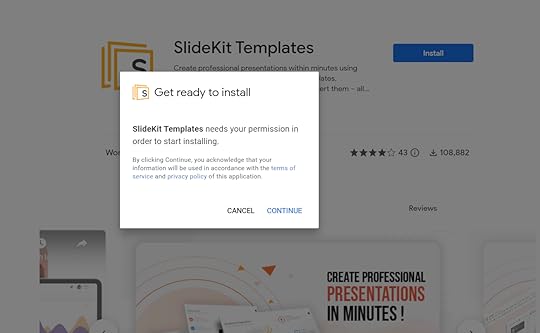 Easy install in ChromeSlide quality and design
Easy install in ChromeSlide quality and designThe first thing that is important to me is the quality of the slides. If I am using them for work purposes, they need to be non-cheesy. In other words, nicely designed.
My first search, for ‘project plan’ turned up only 3 slides. They were all fine, but not ones I would want to use. When I searched for ‘timeline’ I found a good selection of timelines including roadmaps, horizontal and vertical Gantt-style timelines, milestone charts and some others more like infographics.
Using the keyword ‘Risk’ gave me infographics on RAID, a risk breakdown structure, some risk assessment matrices and a few poka yoke diagrams which were cool.
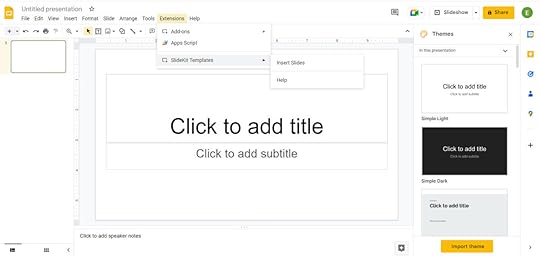 This is how SlideKit looks in Google Slides
This is how SlideKit looks in Google SlidesI also found plenty of general business templates like nice displays for meeting agendas. To save having a mismatch of slide designs, it would be good if you could find slides that were from the same ‘family’ so your conclusion slide was designed in a cohesive way to match your agenda slide. There probably are matching slides out there, but because of the way it is presented, it is tricky to find them.
I found some that I wouldn’t use for work for me (like ‘Happy Thanksgiving!’ and cheesy turkey picture), but that would be OK in other settings, like an early years classroom.
PricingThe essential yearly plan is a reasonable price, and if you build presentations for work, it will save you the effort of designing nice-looking infographic style elements for your decks.
There are over 100 free templates, which are fine – reasonable designs that you can edit to match your organization’s colors.
Free users are expected to add attribution to SlideKit in the presentation, which is not something appropriate for corporate presentations but might be fine for other settings. Becoming a paid member removes the need for attribution.
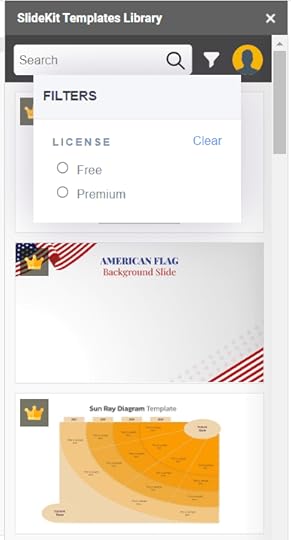 Filter by licence to see content you can accessEase of use
Filter by licence to see content you can accessEase of useWhen logged into Google account, you can just click ‘Use Template’ and it opens up a new Google Slides document with the template loaded.
That worked fine from the website, but from within Google Slides itself, using the add on, you have to log in again so it recognizes you as a premium user.
Then, just search and choose what you want from the template sidebar, and click to insert the complete slide in your presentation. It’s really very easy.
I read some of the other online reviews for the product, and found that people have difficulty logging in when they have multiple Google accounts. You need to only be logged into the account registered with SlideKit in order for the add-on to work. Otherwise Google Slides gets confused – this is an issue in the way Google Slides works and as far as I know, every add-on has the same challenge, but it’s just something to be aware of. This wasn’t an issue for me, as I was using a ‘clean’ browser window in Chrome and managed to log in fine.
Editing slidesIt was easy enough to edit the slides I downloaded into my presentation. The design elements were grouped for ease, but once they were ungrouped I could change the colours etc and format the slide to fit the rest of my design.
Some of the elements cannot be recolored, for example detailed pictures and graphics that come ‘as one’ but the infographic elements can be changed to whatever color best fits your presentation theme or brand.
I found it a challenge to find similar style slides, and I would have liked an option to browse by theme or something like that. Then I could more easily select slides with a common look and feel, similar-style icons and so on, for a more cohesive presentation.
Advantages of SlideKitHere are the main advantages of using SlideKit as I see them:
There are plenty of templates.There’s virtually no learning curve. It’s really easy to use.It integrates seamlessly with Google Slides, so it’s good for time-saving.There’s really not much more to say. It does what it says on the tin.
Disadvantages of SlideKitAs with all tools, there are some things I wanted to work a bit better. Here are the limitations of SlideKit:
I found it easier to browse the website for the design I wanted and then go over to the Slides presentation, use the add-on and search for the exact design by keyword. You can see more slides on the website page than you can in the Google Slides sidebar.There is no way to save your favorites so you can easily find them again. You can do this yourself by just making your own presentation of favorite designs, but it would be cool to have a favorite option to save you searching.Ready to give it a go? Download the add-on for Google Slides for free, and check it out.
I was paid for my time to review this product, but all opinions are my own.
This article first appeared at Rebel's Guide to Project Management



